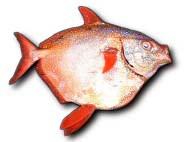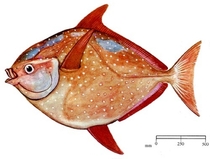Cravo
Opah - Mysterious Ocean Fish
 The opah (Lampris guttatus) is also called the moonfish, spotted moonfish, sunfish, redfish ocean pan, John Dory and the Jerusalem haddock. There is so little information known about the opah that biologists do not even know if the species is endangered. The opah is fished for sport and for its meat. It is considered a delicacy, although only 35 percent of the fish is edible. Its body is mostly made up of bones and skin too tough to chew.
The opah (Lampris guttatus) is also called the moonfish, spotted moonfish, sunfish, redfish ocean pan, John Dory and the Jerusalem haddock. There is so little information known about the opah that biologists do not even know if the species is endangered. The opah is fished for sport and for its meat. It is considered a delicacy, although only 35 percent of the fish is edible. Its body is mostly made up of bones and skin too tough to chew.
The opah is a mid water fish that is often caught with billfish and tuna. Opah are often found at depths from 330 to 1310 feet (100 to 400 meters.) They must swim at higher elevations in order to pursue prey such as squid, krill, cuttlefish, marine wood lice and small fish. Its main predators are large sharks such as mako sharks, orcas and humans. Many opha carry parasites like tapeworms.
Physical Description
An adult opah resembles a huge dinner plate with red fins and lips. The body scales are red, but in the water the fish may appear blue or grey with white spots and a silvery belly. The fins appear small in comparison to the rest of the body. The eyes are gold or yellow. The red mouth lacks teeth. Adults can grow to a remarkable diameter of 6.5 feet (2 meters) long and weigh 595 pounds (270 kilograms.) The flesh is pink but turns white when cooked.
The opah's side or pectoral fins resemble red penguin flippers. Like penguins, opah flap these fins in order to swim, making them appear to "fly" through the water. Although the mouth lacks teeth, the upper jaw can reach out over the lower jaw to latch onto prey and help the fish suck the prey into its body.
Life Cycle and Behavior
Unfortunately, not much is known about how opah live and what they need in order to continue their survival. It is known that they prefer warmer water and wander over the planet's oceans in search of it. They have been found in the Atlantic, Pacific and Indian Oceans. It sometimes ventures the warm Mediterranean Sea.
The opah is an egg-laying fish. The opah is thought to breed in the spring. Eggs vary in diameter from 0.31 to 0.98 inches (0.8 to 2.5 millimeters.) Opah fry look very different from the adults. They resemble tiny plankton without the upper and lower fins of the adults. This fish's lifespan is unknown.


